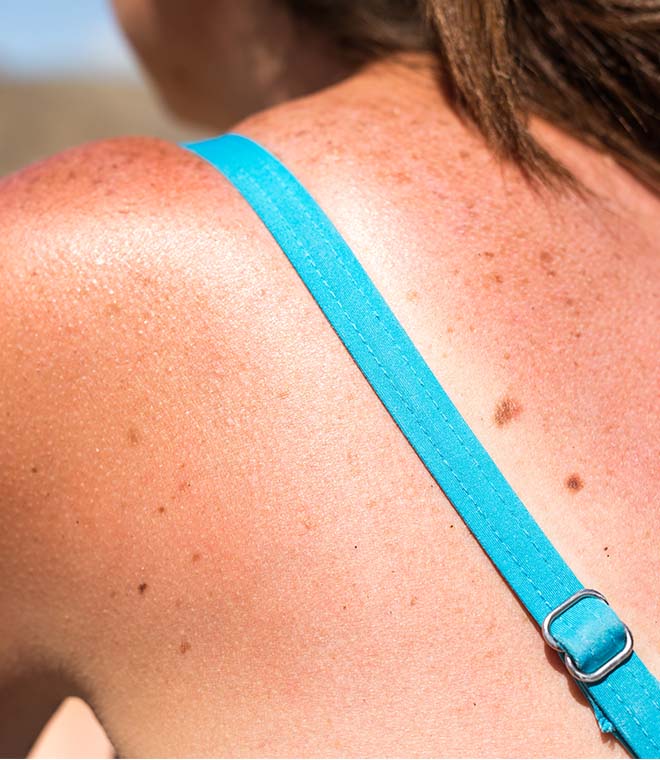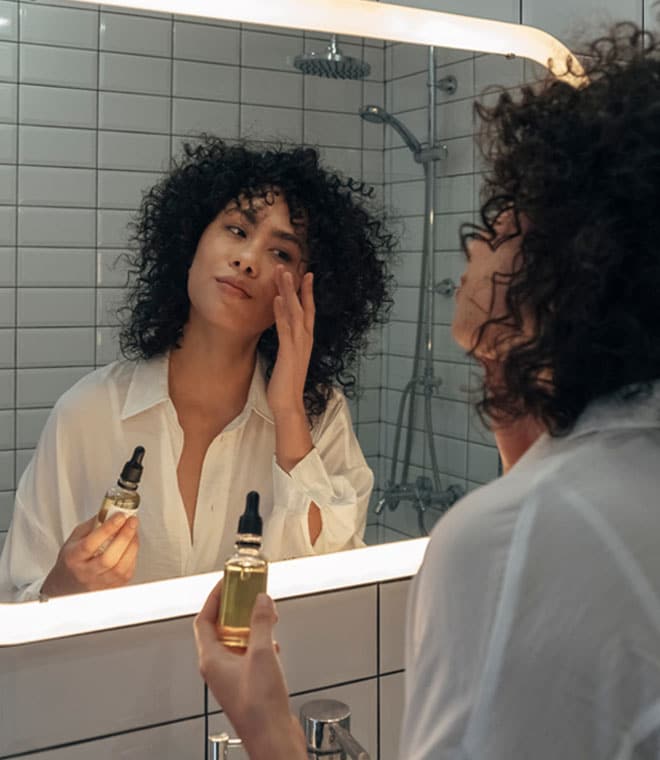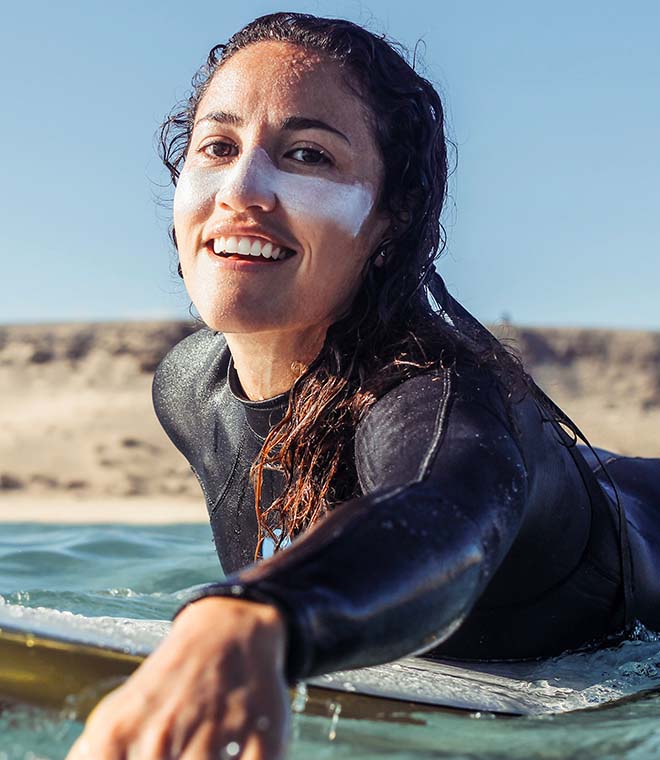Beauty
Acne treatment for teens
By Dr. Anna H. Chacon, MD, Fellow of the American Academy of Dermatology Sep 26, 2023 • 12 min.
Acne is common during the teen years due to hormonal changes that occur during puberty. While acne is a source of embarrassment and frustration for many teens, there are treatments available to help reduce breakouts and promote a healthy complexion—and a more confident teen.
What’s the most common cause of teenage acne?
While acne can affect anyone of any age, it’s most common in teenagers, and it’s often one of the first signs of puberty. Hormonal changes that occur during adolescence may increase the production of sebum, the oil that’s produced by sebaceous glands in the hair follicles (pores) on the skin. Excess oil can clog the pores, causing acne to develop.
Does stress cause acne?
While stress alone doesn’t always cause acne, research shows a significant link between acne breakouts and stress. Chronic stress, which is continual, can be a trigger for acne breakouts. That’s because chronic stress increases levels of hormones like cortisol, which sends oil glands into overdrive. Excessive sebum mixes with dead skin cells, and when bacteria grows, breakouts occur.
While reducing your stress won’t necessarily prevent breakouts, it may help reduce the intensity and frequency.
Acne treatment for teens
The good news about teenage acne is that it’s treatable. Treatment options for acne include over-the-counter topical ointments, creams and cleansers, as well as prescription topical and oral medications.
A board-certified dermatologist who specializes in acne and related skin disorders can determine the type of acne a specific teen has and the best course of treatment based on skin type, underlying causes, severity and other factors.
Over-the-counter treatments
Some examples of over-the-counter treatment options for teenage acne include:
- Salicylic acid: A range of cleansers, creams and spot treatments containing salicylic acid are available over-the-counter. Salicylic acid helps soften and exfoliate the top layer of skin, and it may help reduce the occurrence of breakouts.
- Benzoyl peroxide: Found in face washes, lotions and spot-treatment gels, benzoyl peroxide is an antiseptic and anti-inflammatory medication that reduces the amount of acne-causing bacteria on the skin. Benzoyl peroxide can cause the skin to dry and peel, and it may irritate sensitive skin or cause itching and redness.
- Adapalene: Available over-the-counter in a low concentration, adapalene is a retinoid medication effective for treating mild acne. It works by decreasing swelling and inflammation and helps prevent pimples from forming under the skin. Although acne may get worse initially with adapalene treatment, it generally improves after 8 to 12 weeks.
Some topical over-the-counter treatments are also available in prescription strength to treat more severe cases of acne.
Topical retinoids by prescription
Topical retinoids are a class of medications that are derived from vitamin A and promote exfoliation, or the shedding and removal of dead skin cells. They also promote the production of new skin cells. The new skin cells help push dead skin cells out of blocked pores to clear up acne breakouts. These medications are available in various strengths.
Prescription topical retinoids used to treat teenage acne include tretinoin topical (Avita, Retin-A) and tazarotene topical (Tazorac). Prescription-strength adapalene (Differin) is a little gentler than tretinoin and tazarotene topicals. Retinoid creams, gels and liquids are typically applied once daily in a very thin layer. They may cause mild skin irritation, and your acne may get worse initially before it starts to improve.
Antibiotics in different forms
Antibiotics are a class of medications that kill or slow down the production of certain bacteria. They’re available as oral medications you take as a pill or as topical creams, gels or ointments. The most common topical antibiotics used to treat acne are erythromycin, clindamycin and minocycline.
- Erythromycin topical: This antibiotic stops the growth of certain bacteria that cause some types of acne. It’s generally applied twice daily and may cause side effects such as dry, scaly skin or an allergic reaction.
- Clindamycin topical: This medication can help slow or stop the growth of acne-causing bacteria on the skin. It may cause oiliness, dryness or peeling.
- Minocycline topical: This antibiotic is in the tetracycline class of medications, and it effectively kills the bacteria infecting the pores and reduces sebum production to prevent and minimize breakouts. It’s usually applied to the affected area once a day. It can cause sensitivity to sunlight, so be sure to protect your skin from the sun if you’re using these kinds of antibiotics topically.
Many topical antibiotics also contain other medications, such as retinoids or benzoyl peroxide, which can help reduce the risk of bacterial resistance often associated with using antibiotics.
Oral antibiotics
Medications taken in pill form, including oral antibiotics, may be used to treat moderate to severe teenage acne that doesn’t respond to over-the-counter or prescription topical treatments. Antibiotics may lessen the effect of oral contraceptives. Oral medications used to treat acne include:
- Tetracyclines: The class of antibiotics most commonly used to treat acne are tetracyclines, which include doxycycline, minocycline and sarecycline. These medications have antibacterial and anti-inflammatory properties, and treatment generally lasts two to three months. Side effects can include nausea, diarrhea and a heightened risk of sunburn. Tetracyclines are not advised during pregnancy.
- Trimethoprim-sulfamethoxazole: An antibiotic in the sulfa class, this medication is effective for treating moderate to severe acne and other skin conditions. This medicine can be effective for people who do not tolerate tetracyclines well.
- Cephalexin: This medicine may be prescribed for the treatment of acne. It can be safe for children in certain doses, and it’s generally considered safe to take during pregnancy. It’s typically prescribed for use twice a day under the care of a healthcare provider.
- Amoxicillin: Not the best antibiotic for treating acne, amoxicillin, a member of the penicillin family, may be prescribed for people who can’t take other types of antibiotics. Side effects may include nausea and yellowing of the skin and eyes.
Oral antibiotics are generally prescribed for up to four months, and they help stabilize the skin while other treatments are used to get the acne under control.
Isotretinoin (Absorica) for treating teenage acne
Isotretinoin is an oral retinoid formerly marketed in the U.S. under the popular name Accutane. Isotretinoin is highly effective for treating difficult or severe cases of acne, but it comes with a risk of serious side effects, which usually improve within a few weeks of ending treatment. Mild side effects include dry skin, lips, sinuses and eyes. More severe side effects may include increased cholesterol, joint and muscle pain, and a higher risk of birth defects in pregnant women, along with neurological, blood sugar and vision problems.
This medication works on several fronts to treat acne. It targets clogged pores, bacteria production, inflammation and sebum production. Acne generally gets worse before it gets better on this medication, but the treatment offers a prolonged and sometimes permanent cure in the majority of people who take it.
Before taking isotretinoin, patients must join the U.S. Food and Drug Administration’s iPledge program and sign a consent form attesting to their understanding of the potential severe side effects of this medication. The iPledge program ensures people on this medication receive the supervision and regular blood testing required to catch and address side effects early.
Laser and light treatments for acne
Studies show that light treatments, including lasers, can help reduce acne and help improve scars. However, light therapies rarely work effectively on their own and are generally used as part of a comprehensive treatment plan that includes topical or oral medications. Most people need multiple treatments to see significant results, and while the results are long-lasting, follow-up treatments once or twice a year are needed to maintain the results.
- Laser treatment: Once acne is somewhat under control, laser treatment with visible light may be used to help reduce the appearance of scars and treat difficult cases of acne, reducing the frequency and severity of breakouts.
- Infrared light treatment: Like visible light treatment, infrared light treatment also works on pimples, including those that occur on the back, but it isn’t effective for other types of acne lesions.
- Photodynamic therapy (PDT): This therapy involves applying a solution that makes skin more sensitive to light, then using a laser or light device to treat the skin. PDT is very promising for treating severe acne, including cysts, nodules and other acne lesions.
- Photopneumatic therapy: Although this treatment is very effective on blackheads, whiteheads and some pimples, it’s not effective for nodules or cysts. Photopneumatic therapy involves aiming a narrow, intense pulsed light (IPL) and a gentle vacuum at the affected areas to remove excess oil and dead skin cells from clogged pores.
Many of these medications, including nonprescription medications, carry a risk for pregnant women. Talk with your healthcare provider or pharmacist if you are concerned.
Acne is the most common skin condition in teenagers, and severe acne can cause serious self-esteem issues. Fortunately, oral and topical treatments available in both over-the-counter and prescription form can have a big impact on teenage acne.
If your teenager has acne, and over-the-counter topical treatments aren’t cutting it, see your dermatologist for an evaluation and individualized treatment plan. With the right treatment, teens often achieve clearer skin and healthy skin care habits that keep their skin healthy—and their self-esteem intact—for the long term.
Clinically reviewed and updated September 2023.
Dr. Anna H. Chacon is a double Ivy League-educated board-certified dermatologist. Following medical school at Brown University, Dr. Chacon completed a fellowship in dermatologic & laser surgery at the University of Miami, in which she authored many articles, book chapters, and managed several clinical research studies. She then completed a one-year surgical internship at Orlando Regional Medical Center. She completed her dermatology residency at LAC+USC Medical Center in Los Angeles. She is currently a board-certified dermatologist in South Florida. She speaks multiple languages including English, Spanish, and French; and aspires to treat her patients like family. She has an interest in rural health and providing healthcare to underserved areas. She serves as the first and only dermatologist that provides medical care to the Native Americans of the arctic slope of Alaska. She currently is the most licensed female dermatologist and is licensed in 46 states to practice medicine across state lines. She loves dermatology and also enjoys writing in publications, magazines, online websites, research studies, and scientific articles.
Sources:
- https://www.aad.org/public/diseases/acne/derm-treat/lasers-lights
- https://www.ncbi.nlm.nih.gov/books/NBK525949/
- https://www.mayoclinic.org/drugs-supplements/erythromycin-topical-route/precautions/drg-20068690?p=1
- https://www.mayoclinic.org/drugs-supplements/clindamycin-topical-route/description/drg-20063064
- https://www.mayoclinic.org/drugs-supplements/tetracycline-class-oral-route-parenteral-route/description/drg-20069585
- https://www.mayoclinic.org/diseases-conditions/acne/in-depth/acne-products/art-20045814
- https://medlineplus.gov/druginfo/meds/a604001.html
- https://kidshealth.org/en/teens/acne.html
- https://www.mayoclinic.org/drugs-supplements/cephalexin-oral-route/side-effects/drg-20073325?p=1
- https://www.mayoclinic.org/drugs-supplements/minocycline-topical-application-route/precautions/drg-20475090
- https://my.clevelandclinic.org/health/drugs/19438-clindamycin-topical-lotion
- https://www.aad.org/public/diseases/acne/derm-treat/isotretinoin/side-effects



